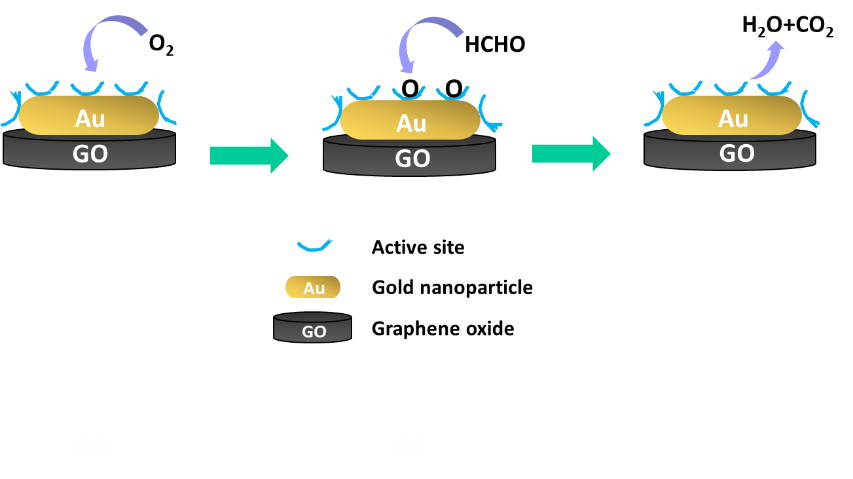การสังเคราะห์วัสดุลูกผสมแกรฟีนและอนุภาคทองนาโนสำหรับใช้เป็นตัวเร่งปฏิกิริยาในการสลายตัวของฟอร์มาลดีไฮด์
คำสำคัญ:
วัสดุลูกผสม, แกรฟีน, อนุภาคทองนาโน, ตัวเร่งปฏิกิริยา, ฟอร์มาลดีไฮด์บทคัดย่อ
งานวิจัยนี้ได้ศึกษาการสังเคราะห์วัสดุลูกผสมแกรฟีนและอนุภาคทองนาโนด้วยกระบวนการอย่างง่ายโดยใช้แกรฟีนออกไซด์มาคอมโพสิตร่วมกับอนุภาคทองนาโนที่ความเข้มข้น 1, 4, 8, 40 และ 80 เปอร์เซ็นต์โดยน้ำหนัก คอมโพสิตที่ได้ที่เงื่อนไขการสังเคราะห์ที่พีเอชต่างๆ จะถูกนำไปทดสอบสมบัติการเป็นตัวเร่งปฏิกิริยาสำหรับการสลายตัวของฟอร์มาลดีไฮด์ด้วยเทคนิค ยูวี/วิสิเบิลสเปกโทรสโกปี จากผลการทดลองพบว่าวัสดุลูกผสมแกรฟีนและอนุภาคทองนาโนที่ความเข้มข้นของอนุภาคทองนาโน 8 เปอร์เซ็นต์โดยน้ำหนักที่พีเอช 10 ให้ค่าการสลายตัวของฟอร์มาลดีไฮด์ได้สูงถึงร้อยละ 36 และเมื่อเพิ่มความเข้มข้นของอนุภาคทองนาโนเป็น 40 และ 80 เปอร์เซ็นต์โดยน้ำหนัก ค่าร้อยละการสลายตัวของฟอร์มาลดีไฮด์เกิดเพิ่มมากขึ้นกว่า 80 เปอร์เซ็นต์ วัสดุลูกผสมแกรฟีนและอนุภาคทองนาโนที่สังเคราะห์ได้ในงานวิจัยนี้จึงมีศักยภาพต่อการนำไปประยุกต์ใช้เป็นตัวเร่งปฏิกิริยาสำหรับการสลายตัวของฟอร์มาลดีไฮด์ที่ปนเปื้อนในสารละลายหรือของเหลวต่างๆ ได้
เอกสารอ้างอิง
Abraham S, König M, Srivastava SK, Kumar V, Walkenfort B, Srivastava A. A Carbon nanostructure (0-3 dimensional) supported isolated gold nanoparticles as an effective SERS substrate. Sens. Actuators 2018;273:455-465.
Ayati A, Ahmadpour A, Bamoharram FF, Tanhaei B, Mänttärid M, Sillanpää M. A review on catalytic applications of Au/TiO2 nanoparticles in the removal of water pollutant. Chemosphere 2014;107:163–174.
Chen FC, Chuang MK, Hsu CS. Gold nanoparticles-graphene oxide nanocomposites that enhance
the device performance of polymer solar cells. Journal of Nanomaterials 2014. Article ID 736879.
Available from https://doi.org/10.1155/2014/736879.
Choi HC, Park Y, Koo JY, Kim S, Choi HC. Spontaneous formation of gold nanoparticles on graphene by galvanic reaction through graphene. ASC Omega 2019;4:18423-18427.
Choucair M, Thordarson P, Stride JA. Gram-scale production of grapheme based on Solvothermal synthesis and sonication. Nat Nano 2009; 4(1):30-33.
Hummer WS, Offeman RE. Preparation of graphite oxide. J Am Chem Soc 1998;80:1339.
Lerf A, He H Y, Forster M, Klinowski J. Structure of graphite oxide revisited. J. Phys. Chem 1998;102:4477-4482.
Li D, Muller MB, Gilje S, Kaner RB, Wallace GG. Processable aqueous dispersions of graphene nanosheets. Nature Nanotechnology 2008;3:101-105.
Lu J, Yang JX, Wang J, Lim A, Wang S, Loh KP. One-Pot synthesis of fluorescent carbon nanoribbons, nanoparticle and graphene by the exfoliation of graphite in ionic liquids. ACS Nano 2009;3(8):2367-2375.
Nepal D, Ren Y, Rao R, Bhusal S, Varshney V, Kedziora G, Wheeler R, Kang Y, Roy A. Hierarchical assembly of gold nanoparticles on graphene nanoplatelets by spontaneous reduction: Implications for smart composites and biosensing. ASC Appl. Nano Mater 2020; 3:8753-8762.
Novoselov KS, Geim AK, Morozov SV, Jiang D, Zhang Y, Dubonos SV. Electric field effect in atomically thin carbon films. Science 2004;306(5696):666-669.
Pandy PC, Shukla S, Pandy Y. 3-Aminopropyltrimethoxysilane and graphene oxide/reduced graphene oxide-induced generation of gold nanoparticles and their nanocomposites: electrocatalytic and kinetic activity. RSC Adv 2016;6(84).
Park S, Ruoff RS. Chemical methods for the production of graphenes. Nat Nano 2009;4(4):217-224.
Sirajuddin, Mechler A, Torriero AAJ, Nafady A, Lee CY, Bond AM, Mullance APO, Bhargava SK. The formation of gold nanoparticles using hydroquinone as a reducing agent through a localized pH change upon addition of NaOH to a solution of HAuCl4. Colloids and Surfaces 2010;370:35-41.
Movahed SK, Fakharian M, Dabiri M, Bazgir A. Gold nanoparticle decorated reduced graphene oxide sheets with high catalytic activity for Ullmann homocoupling. RSC Adv 2014;4(10):5243-5247.
Zhu X, Cheng B, Yu J, Ho W. Halogen poisoning effect of Pt-TiO2 for formaldehyde catalytic oxidation performance at room temperature. Applied Surface Science 2016;364:808-814.

ดาวน์โหลด
เผยแพร่แล้ว
รูปแบบการอ้างอิง
ฉบับ
ประเภทบทความ
สัญญาอนุญาต
ลิขสิทธิ์ (c) 2023 มหาวิทยาลัยพะเยา

อนุญาตภายใต้เงื่อนไข Creative Commons Attribution-NonCommercial-NoDerivatives 4.0 International License.
ผู้นิพนธ์ต้องรับผิดชอบข้อความในบทนิพนธ์ของตน มหาวิทยาลัยพะเยา ไม่จำเป็นต้องเห็นด้วยกับบทความที่ตีพิมพ์เสมอไป ผู้สนใจสามารถคัดลอก และนำไปใช้ได้ แต่จะต้องขออนุมัติเจ้าของ และได้รับการอนุมัติเป็นลายลักษณ์อักษรก่อน พร้อมกับมีการอ้างอิงและกล่าวคำขอบคุณให้ถูกต้องด้วย







